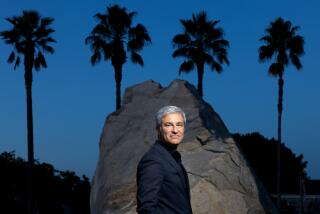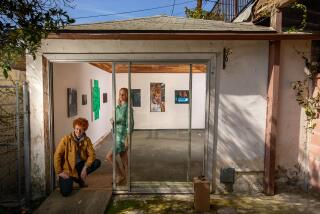Art Review : Relocated LACE Experiences Some First-Show Jitters
The much-awaited relocation of Los Angeles Contemporary Exhibitions (or LACE, as it is universally known) from a warehouse district in downtown Los Angeles to a storefront in the center of downtown Hollywood has finally been accomplished--and not a moment too soon. Lately it had seemed that the venerable, artist-run alternative space was in danger of being completely forgotten. Out of sight, out of mind.
The art scene has been metamorphosing dramatically during the 15 years that the nonprofit gallery has been in operation. Locally, nationally and internationally, the cultural landscape of 1994 would be unrecognizable to a time-traveling visitor from 1979. For much of that time LACE changed with it.
Fluidity is essential to the profile of an alternative space, since the seemingly inevitable institutionalization of art amounts to a cultural hardening of the arteries. That stale rigidity is what spaces like LACE are finally created to be alternatives to.
The liveliness of an alternative space depends on its ability to constantly reposition itself, in order to keep as many options as possible open for artists. In recent years, however, LACE has struggled to keep its artistic head above the churning water.
Certainly there have been individual programs of note. But, overall, the organization seemed stuck, responsive more to parochial or clubbish interests than to artists’ clear-eyed assessments of the larger art scene, and of how to bust up the restrictions it inevitably imposes on our cultural life.
As with the organization’s earlier relocation from the third floor above a bridal shop on downtown L.A.’s Broadway to a free-standing building in a nearby industrial warehouse district, the move to Hollywood was engineered with the help of the Community Redevelopment Agency. The shift to a highly visible street location on Hollywood Boulevard signals a welcome shot of revitalization for LACE.
There’s still a good bit of work to be done, some of it on the reconfigured but still pleasantly scruffy building. More important, as the inaugural show attests, the exhibition program needs to sharpen its focus.
Architecturally, the structure is plainly well-considered in its redesign, while far from spit-and-polished; that mix is appropriate for an alternative space for art. The 4,000-square-foot storefront--formerly a beauticians’ school, wryly enough--has been reconfigured by architect (and LACE board member) Frederick Fisher to create two exhibition galleries, a performance and film theater, a video gallery and office space. Ceilings are high, floors are plywood.
The smaller exhibition gallery in front is open and inviting, thanks to street-side glass walls that casually entice passersby to look inside. In the main exhibition gallery, reached through an unadorned yet monumental doorway, some of the building’s original, Streamline Moderne detailing peaks through, acknowledging layers of past use.
The inaugural exhibition, elliptically titled “Nor Here Neither There,” has been organized by a team composed of three artists (whose own work bears scant resemblance to one another) and by a curator for a major LACE patron. Artists Charles Gaines, Paul McCarthy and Stephen Prina, together with curator Fran Seegull, have, as the show’s title suggests, abandoned all claims on a unified theme. Instead, each apparently chose a few artists whose work they admire, and here they all are.
The selection doesn’t appear entirely random, though. The 13 artists are based in a variety of cities (mostly in the United States, but one in Vancouver and one in Berlin), and they work in just about every medium, including photography, video, performance, sculpture, painting and installation.
No singular artistic strategy is encountered within a single medium. Assemblage, for example, is as diverse as the grubby street-poetics of Nari Ward’s jaunty “Sky Juice,” in which an iron gate clotted with rags sports an umbrella festooned with melted-plastic soda bottles, and the spotless, low-tech computer-space implied by Chris Finley’s eccentric stacks of synthetic paraphernalia.
The most captivating work is Stan Douglas’ projected video, “Monodramas,” which is accompanied by a group of 10 photographs with texts. The latter are like miniature shooting scripts, several of which are acted out in the brief video vignettes. Each less than a minute, the monodramas tell banal tales of random suburban encounters, all in gorgeously saturated color, and all strangely haunted (or haunting) in their peculiar ordinariness.
Looking at the “Monodramas” is like stumbling onto crime scenes. Douglas manages to pack each one with enough mundane but compelling detail to make a viewer curious, while also ensuring that no two viewers are likely to come up with the same interpretive story.
It’s likely that “Nor Here Neither There” means to stand as a declaration of breadth, inclusiveness and multiplicity for LACE’s program, which isn’t a bad idea for an inaugural show. But, overall, neither is this a particularly memorable offering--one that rivets attention and makes you eager for more.
To unravel its title: The show is, in fact, rather too close to being “neither here nor there” in feeling. You don’t just consider the art; instead, it feels as if each work has been asked not merely to speak for itself, but to represent a constituency.
To recognize the particularity of different artistic voices is commendable, but the sense of singularity achieved by unforgettable exhibitions has been sacrificed.
* LACE, 6522 Hollywood Blvd., (213) 624-5650, through July 21. Closed Mondays and Tuesdays.
More to Read
The biggest entertainment stories
Get our big stories about Hollywood, film, television, music, arts, culture and more right in your inbox as soon as they publish.
You may occasionally receive promotional content from the Los Angeles Times.











